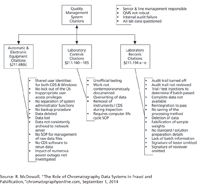Technology to the Rescue for Data Integrity Challenges?
PTSM: Pharmaceutical Technology Sourcing and Management
Informatics platforms and automation solutions may support efforts to improve data integrity practices.
Dmitry Kalinovsky/shutterstock.com

Data shape every decision in the pharmaceutical value chain, from production line optimization to quality control (QC) and quality assurance (QA), batch release, and supply chain logistics. Pharmaceutical manufacturers collect, analyze, and interpret raw data, transforming them into the information that they need to make better decisions.
As competition drives pharmaceutical companies to integrate diverse functions (e.g., research and development with manufacturing, or quality control with supply chain operations), and to connect with outside partners (e.g., university laboratories or contract research and manufacturing organizations [CROs and CMOs]), complete and reliable data are essential, both for business efficiency and regulatory compliance.
To ensure safety and efficacy, any data associated with a pharmaceutical product must be “attributable, legitimate, contemporaneous, original, and accurate,” as FDA has noted (1), using the mnenomic, “ALCOA.” Meeting these requirements for chromatography and laboratory has challenged some manufacturers, and even driven a few out of business, in the past.
In 2004, for example, FDA inspectors accused the pharmaceutical manufacturer Able Labs of fraud (2,3). Inspectors found differences between paper and electronic chromatography data, and learned that some of the company’s staffers had been copying chromatograms from records for passing batches and pasting them onto records for failing ones, reintegrating chromatograms, and adjusting measured weights and calculations to ensure passing quality test results for problematic batches (4).
The company had been using both paper and electronic data systems, and the software’s audit trails ultimately showed who had doctored the data. They were charged with criminal fraud and the company went out of business soon thereafter.
But data integrity continues to challenge pharmaceutical manufacturers around the world. Between 2011 and 2014, FDA issued more than 30 warning letters and form 483s citing problems with data integrity (1). From June 1, 2015 through June 1, 2016, the agency’s inspectors issued 25 warning letters and 483s, according to Douglas Farquhar, principal with the Washington, DC-based law firm, Hyman Phelps & McNamara (5).
Regulatory bodies are demanding the highest standards of consistent data robustness. In 2015, the Medicines and Healthcare Products Regulatory Agency (MHRA) in the United Kingdom and the World Health Organization (WHO) both issued new guidance on data integrity (6, 7). In the United States, FDA updated its draft guidance on data integrity in April 2016 (8,9). These latest efforts aim to safeguard data quality throughout the pharmaceutical development process--from testing, manufacturing and packaging medicines, through to distribution and end-user monitoring.
CLICK FIGURE TO ENLARGE Figure 1. Collated and classified Chromatography Data System (CDS) citations from FDA warning lletters involving a CDS. SOP is standard operating system.

There are prerequisites to ensuring data integrity in lab operations, including those that involve chromatography. First, any and all data must be saved and stored properly and in their original form. Technicians should not enter data into a computerized system, then copy the data on paper, unless systems are in place to verify and store all of that data properly. Any data that have been entered manually must be checked and verified by another person. In addition, access to software and passwords should be available to one person at a time, and not issued to groups of technicians. Another important point is to ensure that the right level of data access is given to people on staff, so that nobody can change results that have already been recorded.
Robert McDowall, a consultant in the UK, has analyzed recent FDA warning letters and European regulatory agency citations to highlight the errors that pharmaceutical labs most often make that involve lab and chromatography data (4). These errors tend to fall into the following categories (see Figure 1):
- Laboratory control issues (e.g., unofficial product testing)
- Automation and equipment issues (data that were not backed up or archived properly, use of shared passwords for access to databases and platforms, no standard operating procedures [SOPs] for data management)
- Laboratory record issues (e.g., no reviewer signatures recorded, deletion or falsification of data, data not entered at the point of record).
However, advances in data management, and specifically the move to integrated informatics systems, have made it easier for companies to ensure the integrity of their data. For example, not only chromatography equipment, but laboratory equipment such as scales can be connected directly into a laboratory information management system (LIMS) to ensure that the correct data are recorded and cannot be tampered with (10).
In addition, there is a need to move beyond ALCOA, to ensure that data are also consistent, complete, enduring, and available. LIMS and chromatography data systems (CDS) can help by having relational databases to record complete data, automatically and consistently, and store them for the long-term, while maintaining the user’s ability to retrieve that data easily.
This article looks at how improvements in LIMS and CDS can help ensure the integrity of data and improve overall laboratory efficiency. These improvements have been driven by user demand for more automation to ensure compliance and data integrity while delivering better usability. As computer systems have evolved, the ability to add more intelligent functionality to laboratory software has increased, enabling the support of smart functions that provide more assurance of data integrity.
The right decision at the right time
For anyone working for a pharmaceutical manufacturing company, making the right decision requires timely access to data that can be trusted. With the evolution of smarter laboratory software, the ability to control and reduce sources of potential data-integrity issues is now in the hands of laboratory managers. Even in a QC lab that uses the most robust chromatographic methods, it can be challenging for technicians to adhere to SOPs every time they run a specific procedure to ensure that routine analyses generate reliable data every time.
When out-of-specification (OOS) results are identified, discovering the root cause of the problem is often a time-consuming, manual process that can only take place after errors have been spotted. Once an error has been identified, troubleshooting a specific chromatographic method can lead to workflow delays, pushing back project deadlines and squeezing budgets.
The latest CDS use intelligent control features such as system suitability testing and run control to allow the results of analytical runs to be recorded more efficiently. By taking automated, in-run pass or fail actions based on real-time chromatographic results, these tools can reduce the number of OOS tests required to determine root cause and help minimize post-run analysis time.
The most up-to-date LIMS can help laboratories not only to identify when runs fail, but to predict when they will fail. Left unchecked, errors that mask small performance problems can grow into much larger quality issues that require costly remediation. Real-time monitoring using statistical algorithms is extending the power of chromatography run-control software. Some integrated systems have been designed with statistical quality control capability built in. Such technology allows real-time process monitoring and trending, and can track nonconformance before it reaches pre-defined thresholds, allowing the overall process to be optimized automatically while the root-cause investigation is still going on.
Unscheduled maintenance in a QC laboratory can cause costly delays to the release of an entire product batch. These delays are often caused by a gradual decline in instrument performance, which, unless detected and trended, can easily be ignored. Integrated informatics systems that control SOPs and capture data from all lab instrumentation and equipment can become a crucial component in increasing laboratory productivity by managing instrument maintenance schedules and reducing downtime.
Monitoring instrument performance
Once trended and analyzed, data such as area counts, baseline conductivity, and retention time provide valuable information on the general health of an instrument. Both CDS and LIMS offer capabilities that allow users to monitor instrument performance so that equipment downtime can be carefully planned as part of a regular maintenance schedule. This way, users can be notified, and workflows can be planned around this schedule.
Another example of how real-time data analysis can streamline workflows and boost operating efficiency is in inventory management. The flow of commonly used disposable labware such as gas chromatography and high-pressure liquid chromatography vials is essential for smooth lab operations. While the cost of an individual vial may be low, the repercussions from poorly managed inventory can be significant. For example, if an inventory for a QC laboratory is depleted, it can have a downstream impact on other workflows, affecting productivity. Such shortfalls can result in the need for expedited delivery, usually at increased expense--which could have been avoided had the shortfall been identified earlier.
Managing the inventory of a single lab running routine tests should be predictable. However, tracking what has been used, when, and by whom is a critical but commonly overlooked step. Using spreadsheets to track consumables cannot support live updates, but LIMS can record and trend usage automatically to ensure vital workflows.
Garbage in, garbage out
Of course, the quality of data depends on how the data are collected. It’s difficult to overstate the importance of developing and documenting SOPs for laboratory workflows. Many laboratories devote considerable time and resources into developing SOPs. Inconsistencies in QC or QA testing protocols, however, can result in costly delays due to compromised regulatory audits. The result puts consumer safety and commercial reputation at risk.
Every company and laboratory has its own approach to creating, distributing, and monitoring SOPs. Many labs still rely on paper-based systems, which suffer from a number of practical limitations. It is time-consuming for analysts to input data manually, when configuring instrumentation. Paper systems are also more prone to human error--especially if analysts are not familiar with the intricacies of a particular system or test. And when changes must be made across a portfolio of workflows to bring them in line with the latest guidelines, it can require significant time and resources to ensure that each individual SOP has been completely updated.
Electronic SOPs (ESOPs) help eliminate some of these problems. With ESOPs defined in a LIMS, for instance, analysts have access to all of the relevant protocol information, ensuring that they adhere to protocols and providing confidence in the robustness of workflows and validity of test results. Some platforms feature built-in lab execution systems (LES) that allow the LIMS platform to interface with the laboratory’s CDS to download method parameters required for a particular SOP and initiate the analytical sequence. This approach ensures that each analysis is performed correctly, and that the data obtained meet the necessary SOP requirements.
Safeguarding data integrity
With QC and QA laboratories responsible for hundreds of tests every week, and each test involving multiple component parts, preparing reports and defending data can involve time-consuming steps to retrieve details of analytical conditions, reagent compositions, and instrument calibration tests. Many of these details are often so deeply embedded in laboratory workflows that it can be extremely difficult to isolate them. In fact, research has shown that pharmaceutical laboratory analysts spend around 15% of their time collecting the data they need to defend a result (11).
The time and productivity lost hunting for these data can be reduced by using integrated information management solutions. Laboratory CDS software automatically records all chromatographic run data and conditions as well as a detailed audit trail of user actions. The latest LIMS can integrate seamlessly with CDS platforms to retrieve all of this information, along with instrument calibration history and colleagues’ laboratory notebooks, giving users access to who did what, when, and why in one location.
FDA recommends that all audit trails capturing changes to critical data be reviewed for every record and before each record’s final approval (8). Audit trails subject to regular review should include any changes to sample run sequences, sample identification, and critical process parameters. To make these checks a matter of course, the most efficient laboratories are using a combination of LIMS and CDS software to review an instrument’s daily audit trails, search and filter for events, and add audits to reports for review.
Integrated informatics platforms such as the latest LIMS offer built-in scientific data management system (SDMS) functionality for this purpose. These systems offer easily configured paperless review and approval procedures and include advanced search and data mining tools to review chromatography and mass spectrometry data, showing when processes are drifting towards nonconformance, giving labs a complete overview of performance based on analyst, instrument, or test.
Given the sensitive nature of commercial or consumer sample data, it is essential to ensure that any changes to records are made only by authorized personnel. Recent advances in LIMS and CDS design have given laboratory managers the ability to control what users can do with data and how they can access it, helping laboratories meet FDA recommendations. Integrated CDS, for instance, track and generate audit trails in real-time by capturing all changes made to data within the software. Modifications can only be permitted by the system administrator, and even then, the software retains details for all versions, allowing users to view all changes, deletions, and additions. Such features help maintain transparency and safeguard data integrity at every stage.
Archiving and storing data
Securing and archiving an ever-increasing amount of data, the lab’s mass spectra and chromatograms documented at the time of analysis, is also a challenge today. It is also a requirement in case of a regulatory question or audit. Modern CDS software will place acquired chromatographic data immediately into a secure database that supports long-term storage. The latest LIMS systems also capture data from non-chromatographic instruments, recording reagent weights and pH meter readings, for example, alongside chromatographic method details, audit trails, report formats, and electronic notes and files, making it easier for all relevant information to be recalled for audit purposes.
When data are generated from multiple instruments or system that use older versions of software, the potential for data incompatibility increases. The latest solutions utilize vendor-neutral formats so that handling data is easier when collaborating with other labs or when integrating QC testing workflows with a manufacturing plant to make decisions on batch release.
Integrated CDS and LIMS solutions are not only helping laboratories and manufacturing facilities comply with the latest current good manufacturing practices, but allowing them to analyze trends in real-time to predict problems before they escalate. These advances in data management can help the industry reach the highest levels of data integrity while bringing safe, effective therapeutic treatments to market more efficiently and affordably.
References
1. J. McCulloch et al., “Data Integrity in the FDA-Regulated Lab,” Regulatory Affairs Professionals Association, Regulatory Focus, April, 2014, posted on clarkstonconsulting.com.
2. “FDA Report Accuses Able Laboratories of Engaging in Massive Fraud to Cover Up Defective Medications,” newsinferno.com.
3. FDA, Enforcement Actions, 2005, fda.gov.
4. R. McDowall, “The Role of Chromatography Data Systems in Fraud and Falsification,” chromatographyonline.com, September 1, 2014.
5. A. Shanley, “Ensuring Supply Chain Safety,” pharmtech.com.
6. MHRA, “GMP Data Integrity Definitions and Guidance for Industry, “Medicines and Healthcare Products Regulatory Agency, London, UK (2016), gov.uk.
7. WHO, Draft Guidance on Good Data and Record Management Practices, World Health Organization, who.org, September, 2015.
8. FDA, FDA Guidance for Industry Data Integrity and Compliance with cGMP, fda.gov, (CDER April 2016).
9. S. Barkow, “Current Expectations and Guidance, including Data Integrity and Compliance With cGMPs,” presented at ISPE’s Workshop, June 5, 2016, Bethesda, MD, fda.gov.
10. R. McDowall, “How LIMS Can Help Ensure Data Integrity,” lcgc.com, June 1, 2016.
11. “Laboratory Informatics in Life Sciences Current State, Technology Trends and the Way Forward,” tcs.com.

Transformations in Drug Development for Cell and Gene Therapies
March 28th 2025As a recognized leader in immunophenotyping for clinical trials, Kevin Lang from PPD discusses how spectral flow cytometry is transforming drug development, particularly in cell and gene therapies like CAR-T. He also dives into his award-winning research, including his 2024 WRIB Poster Award-winning work, and his insights from presenting at AAPS PharmSci360.
Advancing Clinical Trials with Spectral Flow Cytometry: A Conversation with Kevin Lang
March 28th 2025As a recognized leader in immunophenotyping for clinical trials, Kevin Lang from PPD discusses how spectral flow cytometry is transforming drug development, particularly in cell and gene therapies like CAR-T. He also dives into his award-winning research, including his 2024 WRIB Poster Award-winning work, and his insights from presenting at AAPS PharmSci360.